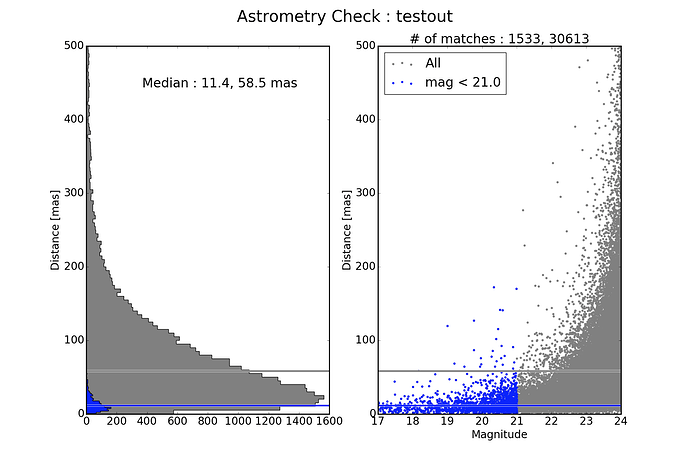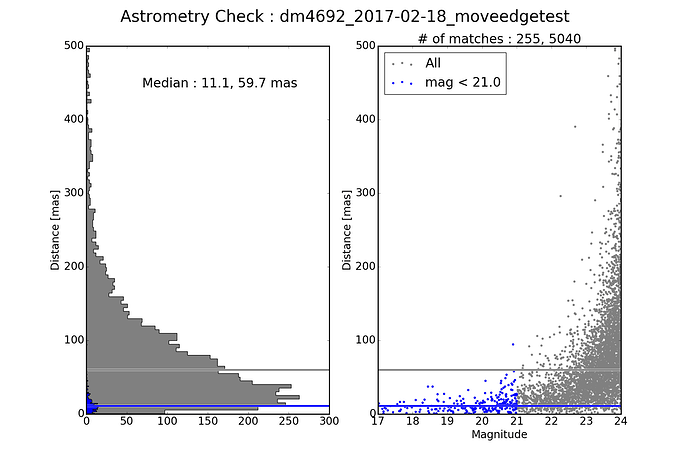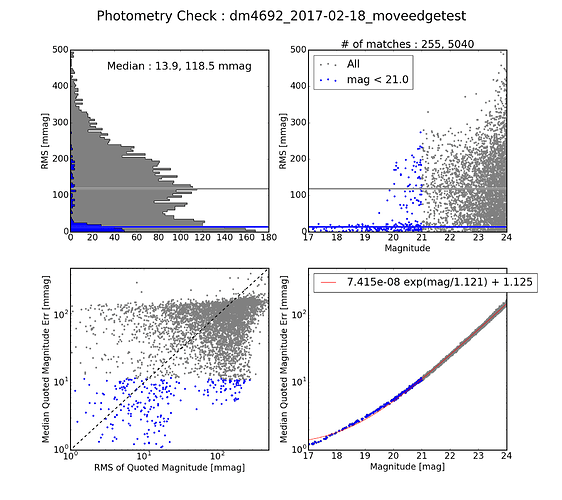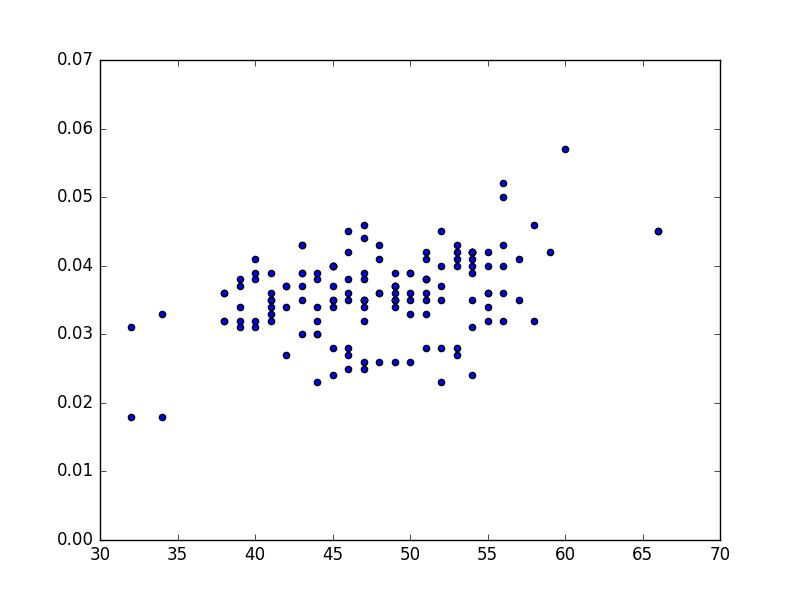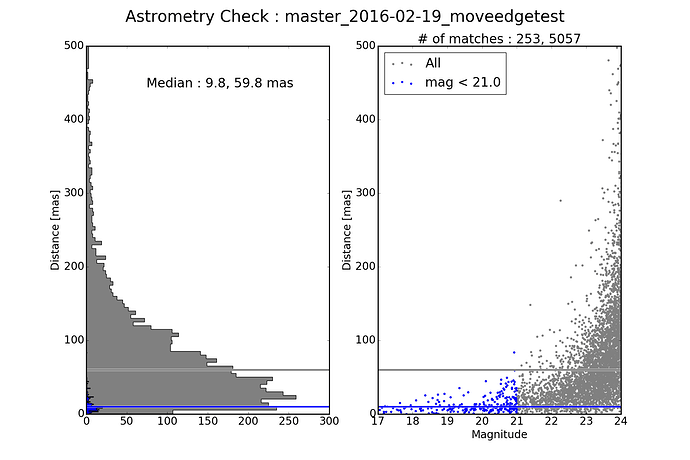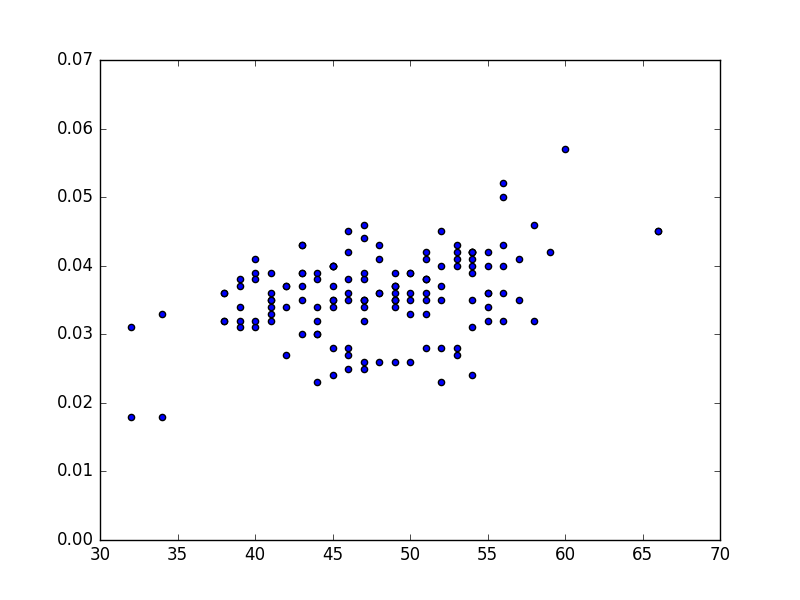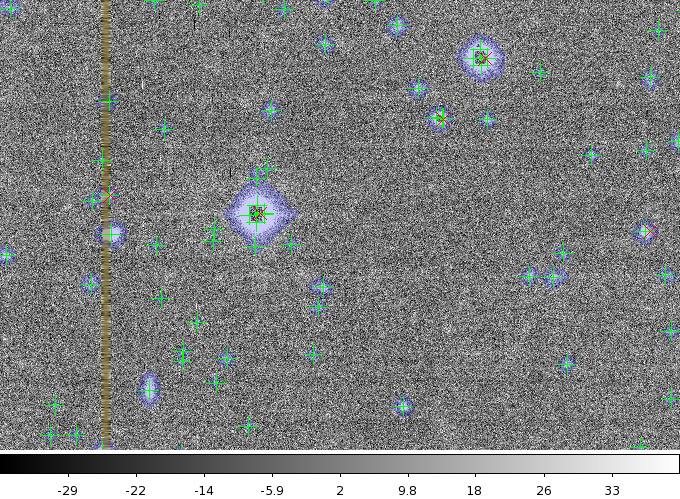I believe the CR problem is due to an incorrect PSF model, which in turn is due to using a relatively bright threshold on the first detection pass. I have found in the past that because of the lower sensitivity in u-band compared to other bands, one usually wants to set charImage.detectAndMeasure.detection.includeThresholdMultiplier=1.0, so the first detection pass gets more stars (this is one reason why I’ve been in favour of removing this). It works in this case too.
price@lsst-dev:~/work/dominique $ processCcd.py input --output output --id visit=994926 ccd=9 --configfile processConfig.py --clobber-config -c charImage.detectAndMeasure.detection.includeThresholdMultiplier=1.0
: Loading config overrride file '/home/price/LSST/obs/cfht/config/processCcd.py'
: Config override file does not exist: '/home/price/LSST/obs/cfht/config/megacam/processCcd.py'
: input=/nfs/home/price/work/dominique/input
: calib=None
: output=/nfs/home/price/work/dominique/output
CameraMapper: Loading registry registry from /nfs/home/price/work/dominique/output/_parent/registry.sqlite3
CameraMapper: Unable to locate calibRegistry registry in root: /nfs/home/price/work/dominique/output/calibRegistry.sqlite3
CameraMapper: Unable to locate calibRegistry registry in current dir: ./calibRegistry.sqlite3
CameraMapper: Loading Posix registry from /nfs/home/price/work/dominique/output
CameraMapper: Loading registry registry from /nfs/home/price/work/dominique/output/_parent/registry.sqlite3
CameraMapper: Unable to locate calibRegistry registry in root: /nfs/home/price/work/dominique/output/calibRegistry.sqlite3
CameraMapper: Unable to locate calibRegistry registry in current dir: ./calibRegistry.sqlite3
CameraMapper: Loading Posix registry from /nfs/home/price/work/dominique/output
processCcd: Processing {'taiObs': '2008-05-29T10:10:11.23', 'extension': 10, 'object': 'D3', 'visit': 994926, 'filter': 'u', 'state': 'p', 'runId': '08AL04', 'date': '2008-05-29', 'ccd': 9, 'expTime': 660.165}
processCcd.isr: Performing ISR on sensor {'taiObs': '2008-05-29T10:10:11.23', 'extension': 10, 'object': 'D3', 'visit': 994926, 'filter': 'u', 'state': 'p', 'runId': '08AL04', 'date': '2008-05-29', 'ccd': 9, 'expTime': 660.165}
processCcd.isr: Saturation set to 70125
processCcd.charImage: Processing {'taiObs': '2008-05-29T10:10:11.23', 'extension': 10, 'object': 'D3', 'visit': 994926, 'filter': 'u', 'state': 'p', 'runId': '08AL04', 'date': '2008-05-29', 'ccd': 9, 'expTime': 660.165}
processCcd.charImage.repair: Identified 2054 cosmic rays.
processCcd.charImage.detectAndMeasure.detection: Detected 2720 positive sources to 5 sigma.
processCcd.charImage.detectAndMeasure.detection: Resubtracting the background after object detection
processCcd.charImage.detectAndMeasure.measurement: Measuring 2720 sources (2720 parents, 0 children)
processCcd.charImage.measurePsf: Measuring PSF
/home/price/LSST/meas/algorithms/python/lsst/meas/algorithms/objectSizeStarSelector.py:372: RuntimeWarning: invalid value encountered in less
bad = numpy.logical_or(bad, width < self.config.widthMin)
/home/price/LSST/meas/algorithms/python/lsst/meas/algorithms/objectSizeStarSelector.py:373: RuntimeWarning: invalid value encountered in greater
bad = numpy.logical_or(bad, width > self.config.widthMax)
/home/price/LSST/meas/algorithms/python/lsst/meas/algorithms/objectSizeStarSelector.py:135: RuntimeWarning: invalid value encountered in less
update = dist < minDist
processCcd.charImage.measurePsf: PSF star selector found 22 candidates
processCcd.charImage.measurePsf: PSF determination using 7/22 stars.
processCcd.charImage: iter 1; PSF sigma=2.31, dimensions=(33, 33); median background=247.62
processCcd.charImage.repair: Identified 2046 cosmic rays.
processCcd.charImage.detectAndMeasure.detection: Detected 2370 positive sources to 5 sigma.
processCcd.charImage.detectAndMeasure.detection: Resubtracting the background after object detection
processCcd.charImage.detectAndMeasure.measurement: Measuring 2370 sources (2370 parents, 0 children)
processCcd.charImage.measurePsf: Measuring PSF
processCcd.charImage.measurePsf: PSF star selector found 21 candidates
processCcd.charImage.measurePsf: PSF determination using 6/21 stars.
processCcd.charImage: iter 2; PSF sigma=2.58, dimensions=(33, 33); median background=247.56
processCcd.charImage.repair: Identified 2045 cosmic rays.
processCcd.charImage.detectAndMeasure.measurement: Measuring 2370 sources (2370 parents, 0 children)
processCcd.charImage.detectAndMeasure.measureApCorr: Measuring aperture corrections for 2 flux fields
processCcd.charImage.detectAndMeasure.measureApCorr: Aperture correction for base_PsfFlux: RMS 0.012687 from 6
processCcd.charImage.detectAndMeasure.measureApCorr: Aperture correction for base_GaussianFlux: RMS 0.007252 from 6
processCcd.charImage.detectAndMeasure.measurement: Measuring 2370 sources (2370 parents, 0 children)
processCcd.charImage.detectAndMeasure.measurement.applyApCorr: Applying aperture corrections to 2 flux fields
processCcd.charImage.detectAndMeasure.measurement.applyApCorr: Use naive flux sigma computation
processCcd.calibrate: Processing {'taiObs': '2008-05-29T10:10:11.23', 'extension': 10, 'object': 'D3', 'visit': 994926, 'filter': 'u', 'state': 'p', 'runId': '08AL04', 'date': '2008-05-29', 'ccd': 9, 'expTime': 660.165}
processCcd.calibrate.detectAndMeasure.detection: Detected 977 positive sources to 5 sigma.
processCcd.calibrate.detectAndMeasure.detection: Resubtracting the background after object detection
processCcd.calibrate.detectAndMeasure.deblend: Deblending 977 sources
processCcd.calibrate.detectAndMeasure.deblend: Deblended: of 977 sources, 86 were deblended, creating 377 children, total 1354 sources
processCcd.calibrate.detectAndMeasure.measurement: Measuring 1354 sources (977 parents, 377 children)
/ssd/price/lsstsw/miniconda/lib/python2.7/site-packages/numpy/core/_methods.py:59: RuntimeWarning: Mean of empty slice.
warnings.warn("Mean of empty slice.", RuntimeWarning)
/ssd/price/lsstsw/miniconda/lib/python2.7/site-packages/numpy/core/_methods.py:70: RuntimeWarning: invalid value encountered in true_divide
ret = ret.dtype.type(ret / rcount)
processCcd.calibrate.detectAndMeasure.measurement.applyApCorr: Applying aperture corrections to 2 flux fields
processCcd.calibrate.detectAndMeasure.measurement.applyApCorr: Use naive flux sigma computation
processCcd.calibrate: Copying flags from icSourceCat to sourceCat for 773 sources
processCcd.calibrate.astrometry.refObjLoader: Loading reference objects using center (1023.5, 2305.5) pix = Fk5Coord(215.5813297, 52.8150844, 2000.00) sky and radius 0.13499220215 deg
processCcd.calibrate.astrometry.refObjLoader: Loaded 85 reference objects
processCcd.calibrate.astrometry.matcher: filterStars purged 0 reference stars, leaving 85 stars
processCcd.calibrate.astrometry.matcher: Purged 1314 unusable sources, leaving 40 usable sources
processCcd.calibrate.astrometry.matcher: Matched 23 sources
processCcd.calibrate.astrometry.wcsFitter: Updating centroids in refCat
processCcd.calibrate.astrometry.wcsFitter: Updating coords in sourceCat
processCcd.calibrate.astrometry.wcsFitter: Updating distance in match list
processCcd.calibrate.astrometry.matcher: filterStars purged 0 reference stars, leaving 85 stars
processCcd.calibrate.astrometry.matcher: Purged 1314 unusable sources, leaving 40 usable sources
processCcd.calibrate.astrometry.matcher: Matched 22 sources
processCcd.calibrate.astrometry.wcsFitter: Updating centroids in refCat
processCcd.calibrate.astrometry.wcsFitter: Updating coords in sourceCat
processCcd.calibrate.astrometry.wcsFitter: Updating distance in match list
processCcd.calibrate.astrometry.matcher: filterStars purged 0 reference stars, leaving 85 stars
processCcd.calibrate.astrometry.matcher: Purged 1314 unusable sources, leaving 40 usable sources
processCcd.calibrate.astrometry.matcher: Matched 21 sources
processCcd.calibrate.astrometry.wcsFitter: Updating centroids in refCat
processCcd.calibrate.astrometry.wcsFitter: Updating coords in sourceCat
processCcd.calibrate.astrometry.wcsFitter: Updating distance in match list
processCcd.calibrate.astrometry: Matched and fit WCS in 3 iterations; found 21 matches with scatter = 0.037 +- 0.021 arcsec
processCcd.calibrate.photoCal: Applying color terms for filterName='u', config.photoCatName=e2v because config.applyColorTerms is True
processCcd.calibrate.photoCal: Magnitude zero point: 32.261447 +/- 0.000699 from 10 stars
processCcd.calibrate: Photometric zero-point: 32.261447
